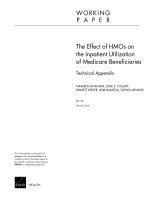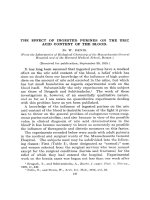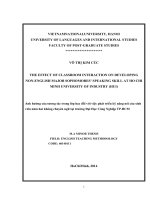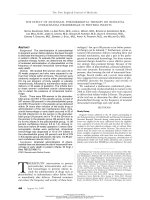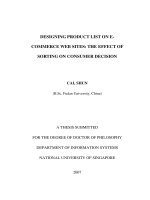The effect of supervisors interpersonal style on postgraduate students skill development, research satisfaction, and quality of life evidence from vietnam
Bạn đang xem bản rút gọn của tài liệu. Xem và tải ngay bản đầy đủ của tài liệu tại đây (3 MB, 80 trang )
UNIVERSITY OF ECONOMICS HO CHI MINH CITY
International School of Business
------------------------------
Nguyen Thi Ha
THE EFFECTS OF SUPERVISOR'S
INTERPERSONAL STYLE ON
POSTGRADUATE STUDENT'S SKILL
DEVELOPMENT, RESEARCH SATISFACTION,
AND QUALITY OF LIFE: EVIDENCE FROM
VIETNAM
MASTER OF BUSINESS (Honours)
Ho Chi Minh City – Year 2015
UNIVERSITY OF ECONOMICS HO CHI MINH CITY
International School of Business
------------------------------
Nguyen Thi Ha
THE EFFECTS OF SUPERVISOR'S
INTERPERSONAL STYLE ON POSTGRADUATE
STUDENT'S SKILL DEVELOPMENT, RESEARCH
SATISFACTION, AND QUALITY OF LIFE:
EVIDENCE FROM VIETNAM
ID: 22130018
MASTER OF BUSINESS (Honours)
SUPERVISOR: Dr. NGUYEN THI MAI TRANG
Ho Chi Minh City – Year 2015
ACKNOWLEDGEMENTS
The completion of this study represents a significant milestone in my life. It has been a
long time when I come back the academic journal and it demands plenty effort. This thesis
could not have been completed without the valuable support and kind encouragement of many
people.
Firstly, I would like to express my genuine appreciation to my supervisor, Dr. Nguyen
Thi Mai Trang for her precious time, countless advice, professional guidance, as well as her
valuable comments in every stage of doing my research. I could not have completed this
research without her teaching and assistance.
I would also like to express my great gratitude to the committee members, Dr. Nguyen
Dinh Tho, Dr. Tran Ha Minh Quan, Dr. Nguyen Thi Nguyet Que and Dr. Nguyen Thi Mai
Trang. Their valuable comments and constructive suggestions contributed significantly for me
to complete this thesis with best results.
My special thank is extended to all instructors and staffs of School International School
of Business – University of Economics Ho Chi Minh City for their great support and
experience sharing during the last two years. In addition, lots of other professors, classmates,
friends, and bosses motivated me in the long journey of postgraduate program.
Finally, the deepest and most sincere gratitude are for my beloved family and my
husband who always facilitate great conditions and kindly encourage me to pursue and
complete MBA program.
ABSTRACT
The concern about postgraduate non-completion and time taken to completion has
attracted to explore recently and supervisor is designated to facilitate the student’s academic
development either in terms of coursework or research projects. To address this problem, the
purpose of this study is to examine the effects of supervisor’s interpersonal style on research
skill development and subsequently, on research satisfaction and quality of life in the context of
Vietnam postgraduate studies. Additionally, it investigates the moderating role of student’s
intrinsic motivation in the relationship between supervisor’s interpersonal style and skill
development. Qualitative research by in-depth interview is managed to make the adopted scales
to be appropriate for the context of the study. Following, quantitative research or main survey is
conducted to test the measurement models and the hypothesized model. With Structural
Equation Modeling (SEM) approach, the research findings indicate that supervisor’s
interpersonal style has a strongly positive impact on student’s skill development, research
satisfaction, and eventually happiness in life. In addition, intrinsic motivation is highlighted to
moderate the relationship of supervisor’s interpersonal style and skill development during
supervisory process. Thus, these findings will be useful for universities, or scientific research
institutions to identify and address implementation issues related to effective supervision in
enhancing postgraduate research studies.
Keywords: effective supervision, supervisor’s interpersonal style, skill development, quality of
life, intrinsic motivation
ACKNOWLEDGEMENT
TABLE OF CONTENTS
ABSTRACT
TABLE OF CONTENTS
LIST OF FIGURES
LIST OF TABLES
CHAPTER 1 - INTRODUCTION ---------------------------------------------------------------------- 6
1.1 Research background -------------------------------------------------------------------------------- 6
1.2 Research gap ------------------------------------------------------------------------------------------ 8
1.3 Research objectives -------------------------------------------------------------------------------- 10
1.4 Research scope ------------------------------------------------------------------------------------- 10
1.5 Research significance ------------------------------------------------------------------------------ 11
1.6 Research Structure --------------------------------------------------------------------------------- 11
CHAPTER 2 - LITERATURE REVIEW AND HYPOTHESES ------------------------------ 13
2.1 Quality of life and research satisfaction --------------------------------------------------------- 13
2.2 Skill development ---------------------------------------------------------------------------------- 14
2.3 Supervisor’s interpersonal style ------------------------------------------------------------------ 15
2.4 Moderating effect of intrinsic motivation ------------------------------------------------------- 17
2.5 Conceptual model ---------------------------------------------------------------------------------- 19
CHAPTER 3 - METHODOLOGY ------------------------------------------------------------------- 21
3.1 Research design ------------------------------------------------------------------------------------ 21
3.1.1 Research process -------------------------------------------------------------------------- 21
Page | 1
3.1.2 Measurement scales ----------------------------------------------------------------------- 21
3.2 Qualitative study ----------------------------------------------------------------------------------- 26
3.2.1 The purpose of qualitative research ----------------------------------------------------- 26
3.2.2 Sample of qualitative research ----------------------------------------------------------- 26
3.2.3 The conduct of qualitative research ----------------------------------------------------- 26
3.2.4 The outcome of qualitative research ---------------------------------------------------- 27
3.3 Quantitative study ---------------------------------------------------------------------------------- 29
3.3.1 Questionnaire design ---------------------------------------------------------------------- 29
3.3.2 The purpose of quantitative research --------------------------------------------------- 30
3.3.3 Sampling ------------------------------------------------------------------------------------ 30
3.3.4 Data analysis method --------------------------------------------------------------------- 31
CHAPTER 4 – DATA ANALYSIS AND RESULTS --------------------------------------------- 33
4.1 Data collection -------------------------------------------------------------------------------------- 33
4.2 Sample characteristics ----------------------------------------------------------------------------- 34
4.3 Cronbach’s Alpha coefficient of reliability test ------------------------------------------------ 36
4.4 Exploratory Factor Analysis (EFA)-------------------------------------------------------------- 40
4.5 Confirmatory Factor Analysis (CFA) ----------------------------------------------------------- 42
4.5.1 Model Fit ------------------------------------------------------------------------------------ 42
4.5.2 Reliability and Validity Check ----------------------------------------------------------- 44
4.5.2.1 Reliability ------------------------------------------------------------------------------ 44
4.5.2.2 Convergent validity ------------------------------------------------------------------- 44
4.5.2.3 Discriminant Validity ----------------------------------------------------------------- 44
Page | 2
4.6 Structural Equation Modeling (SEM) ----------------------------------------------------------- 45
4.7 Testing the moderating effect of intrinsic motivation ----------------------------------------- 48
CHAPTER 5 – CONCLUSION, IMPLICATIONS, AND LIMITATIONS ----------------- 50
5.1 Conclusions and discussion of the findings----------------------------------------------------- 50
5.2 Managerial implications --------------------------------------------------------------------------- 54
5.3 Limitations and future research ------------------------------------------------------------------ 56
REFERENCES ------------------------------------------------------------------------------------------- 57
Appendix A: Guidelines for in-depth interview --------------------------------------------------- 62
Appendix B: Final measurement scales ------------------------------------------------------------- 68
Appendix C: Questionnaire (English version) ----------------------------------------------------- 70
Appendix D: Questionnaire (Vietnamese Version) ----------------------------------------------- 73
Appendix E: KMO and Bartlett's Test and Total Variance Explained ---------------------- 76
Page | 3
LIST OF FIGURES
Figure 2.1 Conceptual model --------------------------------------------------------------------------- 19
Figure 3.1 Research process ---------------------------------------------------------------------------- 22
Figure 4.5 Confirmatory factor analysis (Standardized estimates) -------------------------------- 43
Figure 4.6 Structural results (Standardized estimates) ---------------------------------------------- 46
Page | 4
LIST OF TABLES
Table 3.1 Scale items of supervisor’s interpersonal style ...................................................... 23
Table 3.2 Scale items of skill development ........................................................................... 24
Table 3.3 Scale items of intrinsic motivation ........................................................................ 24
Table 3.4 Scale items of research satisfaction ....................................................................... 25
Table 3.5 Scale items of quality of lify .................................................................................. 25
Table 3.6 Removed items ..................................................................................................... 28
Table 4.1 Source of data collection ....................................................................................... 33
Table 4.2 Respondents’ characteristics ................................................................................. 35
Table 4.3 Cronbach’s Alpha Rule of thumb ......................................................................... 36
Table 4.4 Cronbach’s Alpha coefficients for each measurement scale – first round ........... 37
Table 4.5 Cronbach’s Alpha coefficients for each measurement scale – final round .......... 39
Table 4.6 Pattern Matrix ....................................................................................................... 41
Table 4.7 Key goodness-of-fit indices .................................................................................. 42
Table 4.8 Construct correlations, squared correlations and AVE ......................................... 45
Table 4.9 Fitness of conceptualized Model .......................................................................... 45
Table 4.10 Unstandardized Regression Weights (SEM) ...................................................... 46
Table 4.11 Summary of hypotheses testing result ................................................................ 47
Table 4.12 Difference between variance and partial invariance model ................................ 48
Table 4.13 Estimating for moderating effects of intrinsic motivation ................................... 49
Table D1 KMO and Barlett’s Test ......................................................................................... 76
Table D2 Total Variance Explained in Exploratory Factor Analysis .................................... 76
Page | 5
1.1 Research background
CHAPTER 1 - INTRODUCTION
The relationship between research students and supervisors plays a critical role in the
success of postgraduate thesis. Doing research or thesis is the process involving selecting a
research topic, planning the research, identifying the necessary resources, managing the
project, actively conducting the research, carrying out the literature review, data analysis and
interpretation of the data, writing the thesis, and defending it (Ismail, Abiddin & Hassan,
2011). Obviously, students’ commitments with their studies and their endurance in pursuing
academic path have been addressed as key factors in ensuring completion of their postgraduate
program (Sakurai, Pyhältö & Lindblom-Ylänne, 2012).
Postgraduate students can be listed into three main programs including research,
coursework and research - coursework. Thus, the concern about higher degree non-completion
and time taken to completion has attracted many scholars to explore, especially in overseas, for
example in Canada, Australia and Malaysia. Recent research on postgraduate study experience
has shown that stress, frustration and attrition rates among students are high and the number of
postgraduate students leaving their programs is alarming, ranging from 40% to 70% (Gardner,
2007). The study by Elga (2003) in Canada indicates that the completion rates vary from 45%
to 77% in subject to the major (Arts and humanities: masters 67.9%, doctoral 44.7%; Social
sciences: masters 72.6%, doctoral 48.5%; Natural & Applied sciences: masters 74.5%, doctoral
66.7%; Life sciences: masters 77.1%, doctoral 70.4%). In Australia, the completion rates for
research degrees have increased remarkably since the 1980s to between 80% and 90% in the
mid 1990s (Colebatch, as cited in Ismail et al., 2011). Further, based on the data gathered by
Graduate School of Studies (GSO) of one public university in Malaysia, graduate students with
thesis (research and coursework) complete their Masters averagely within 2.69 years and Ph.D
student complete their Ph.D within 4.84 years averagely in 2005 whereas they can complete it
earlier than that (Abiddin & Ismail, 2011).
Page | 6
In Vietnam, since the economic liberalization “doi moi” in 1986, the higher education
system has expanded in both scale and scope - driven by strong household and labor market
demand. By the early 90s of XX century, it has an outbreak that the postgraduate enrollment
and training numbers have increased remarkably, which creates a leap in Vietnam postgraduate
program. Especially, in recent years, the scale postgraduate training has increased speedily. In
the period 2000 - 2005, the number of master students increased by 51.9%/ year and doctoral
students increased by 61.1%/ year and by early 2014, there are more than 130 institutions for
doctoral degree and 150 training facilities for master's degrees (Đỗ Đức Minh, 2014). Not only
public universities or scientific research institutions specialize in postgraduate training task, but
also the private universities with qualified quality assurance are tasked with postgraduate
training. Yearly, the higher education sector provides 20,000-25,000 masters and thousands of
doctoral (Đỗ Đức Minh, 2014).
In addition to the achieved results, the postgraduate training in Vietnam also reveals
some challenges to address. Firstly, the efficiency and scale of postgraduate program are not in
conjunction with the quality of training. According to many experts, the quality of
postgraduate training is worrying and far from expectation. Hence, the quality of thesis and
research is low, not yet meets international standard in both content and form, especially
reference, data analysis and students neither perform independent research capability
expectedly nor keep up with the development level of science, technology and not associated
with life (Đỗ Đức Minh, 2014). Secondly, very few faculties appear actively engaged in
research and publications. Students are limited to associate with scientific research, self-study
capacity, self-practice and research skill development. The World Bank (2008) reported that
there seem very few publications in Vietnam, but the majority of these are published
domestically, rather than in international peer-reviewed scientific journals while publishing in
international peer reviewed journals is an important test of the quality of research, and an
important tool for improving quality. Thirdly, research projects at many universities are behind
schedule or postponed, with about 70 percent of research projects yet to be evaluated one to
Page | 7
seven years after their stipulated duration completion, as shown in the report (The World Bank,
2008).
Likewise, numerous research findings have pointed out variables that affect
postgraduate studies completion within the stimulated timeframe and the major problem tends
to approach the research and supervision process (Hammick & Acker, 1998; Ssegawa &
Rwelamila, 2009; Ezebilo, 2012; Sakurai et al., 2012; Ngozi & Kayode, 2014).
Correspondingly, supervision is interpreted as a complex social encounter and a two-way
interaction that requires both the student and the supervisor to consciously engage each other
within the spirit of professionalism, respect, and open-mindedness (Ismail et al., 2011). An
empirical study by Hammick and Acker (1998) revealed that the supervisor gender affects
upon the supervision of research through its influence on the knowledge flow and power
between student and supervisor. Further, major reasons for high postgraduate attrition rate
include student research deficiencies, particularly lacking of research skills and failure to
develop a credible and sound research definition and design (Ssegawa & Rwelamila, 2009),
challenges associated with research process and student’s confidence in presenting research
works to the scientific community (Ezebilo, 2012) or supervision process and departmental
issues (Sakurai et al., 2012). Research also shows that supervision schedule, students' interest,
and predisposition towards research work as well as student's skill in conduct of research and
availability of needed research resources are major attributive variables to delay research or
thesis completion (Ngozi & Kayode, 2014). However, majority of research focus on the
supervisor-student interpersonal relationship and supervisor’s interpersonal style plays the vital
role for the success of postgraduate program (Marsh, Rowe & Martin, 2002; Armstrong, 2004;
Allen, Day & Lentz, 2005; Mainhard, Rijst, Tartwijk & Wubbels, 2009; Ruhani, 2012).
1.2 Research gap
In Vietnam, research about the relationship between supervisor’s interpersonal style and
postgraduate student’s skill development and research satisfaction is still limited. So far, the
Page | 8
research of Tran (2013) showed that there is limitation on the skill development in higher
education in Vietnam and it appears the need to develop soft skills, the central-controlled
curriculum, the traditional teaching method, the popularity of students’ passivity to close the
gap between studying and workplace. Furthermore, another empirical research by Tran and
Swierczek (2009) identified factors influencing the graduate skill development in the
workplace via the perspective of employer’s need as well as skill delivery and graduate
competencies in the lens of students only. Meanwhile, Marsh at al. (2002) perceived skill
development during supervisory process as development of generic skills.
Although many researches worldwide have been conducted to investigate the
determinants of postgraduate quality, very few studies specifically explore the relationship of
supervisor’s interpersonal style on postgraduate student’s research skill development and its
consequences in research satisfaction and quality of life. Most of the researches show these
concepts separately (Marsh et al., 2002; Mainhard et al., 2009; Y.K. Lee, Kim, K.H. Lee & Li,
2012; Nguyen & Nguyen, 2012). Further, the role and the degree of students’ selfdetermination and autonomous motivation during the period of doing thesis seem to be
overlooked in the supervisory process. In Vietnam, the number of studies about this issue is
still scare. Even the studies of Tran (2013), Tran and Swierczek (2009) showed that school
activities and part-time experiences effectively enhancing students’ skill development but they
concentrate on a different construct, that is the linkage between postgraduate skilldevelopments in workplace and focus on the competencies applicable in working environment.
Moreover, these above research examine university students and employers as respondents
instead of postgraduate students. What remains to be explored, however, is how postgraduate
students perceive to achieve learning outcome of research skill development and research
satisfaction from doing postgraduate thesis.
Page | 9
1.3 Research objectives
In order to fulfill this gap and in an effort to identify the key factors affecting student’s
skill development during supervision process, the overall objective of this study is to examine
the effects of supervisor’s interpersonal style on research skill development and subsequently,
on research satisfaction and quality of life in the context of Vietnam postgraduate studies. In
addition, it investigates the moderating role of student’s intrinsic motivation in the relationship
between supervisor’s interpersonal style and skill development. Specifically, it investigates:
1. The relationship between research satisfaction and quality of life
2. The relationship between skill development and research satisfaction
3. The relationship between supervisor’s interpersonal style and skill development
4. The relationship between supervisor’s interpersonal style and research satisfaction
5. The impact of supervisor’s interpersonal style on skill development is stronger for
group with a high level of intrinsic motivation than that of group with a low level of
intrinsic motivation
1.4 Research scope
This thesis concentrates on Master’s students who are under doing the postgraduate
thesis and already completed the MBA program because they have deep experience in
supervisory process and research completion. Ho Chi Minh City is chosen to conduct the
survey for this study since it is one of the biggest cities in Vietnam and most of universities
and scientific research institutions centralize here. The survey examines MBA’s students
mainly at four universities in Ho Chi Minh city, Vietnam including University of Economics
Ho Chi Minh City, University of Economics and Law, Ho Chi Minh City University of
Technology and Open University.
Page | 10
1.5 Research significance
This thesis about the relationship between postgraduate students with their supervisors
and the supervisory styles to be most effective in terms of students’ satisfaction with the
supervision in their learning journey is practical for several reasons. First, the author hopes to
provide a general outlook about students’ feedback at their supervisors’ interpersonal styles
with the goal to improve the quality of supervision. Although communication between research
students and supervisors frequently will be open, the research accommodates the instrument to
discuss the relationship and the data will add insights that not always reflect in unregulated
discussion between postgraduate student and supervisor. Second, analyzing what postgraduate
students’ preferred style and what supervisor’s ideal would help in the matching of supervisors
and supervisees. Third, this study is significant for universities or scientific research
institutions specializing in postgraduate training for future program development in order to
enhance or create a climate where evaluation of postgraduate students’ experiences is common
practice. Finally, by having an insight understanding about factors that influence student’s kill
development, research satisfaction, and happiness in life, universities, or scientific research
institutions can have appropriate strategies or specific activities to release the nature tension of
the relationship between supervisors and supervisees and increase the quality of research
supervision in postgraduate education.
1.6 Research Structure
This thesis includes five chapters:
Chapter 1: Introduction
This chapter presents the research background of this study as well as the research gap,
research objectives, research scope, research significance, and research structure.
Page | 11
Chapter 2: Literature review and hypotheses
This chapter describes a conceptual model. Additionally, this chapter reviews and
synthesizes the theories in the literature of five constructs including quality of life, research
satisfaction, skill development, supervisor’s interpersonal styles, and intrinsic motivation.
Thus, the definition and the literature review of the above constructs are presented, and
hypotheses are proposed respectively.
Chapter 3: Methodology
This chapter introduces research design, research methodology, and the processes of
conducting the research to test the hypotheses. In addition, the research procedure is
implemented through a combination between qualitative research and quantitative research.
Chapter 4: Data analysis and results
This chapter is designed to present the data analysis progress and findings of data
analysis. Accordingly, this chapter includes three main parts: descriptive analysis,
measurement assessment, and hypotheses testing.
Chapter 5: Conclusions, Implications, and Limitations
The last chapter discusses main conclusions, discussion of the findings and implications
based on the results of the previous chapters. Lastly, the limitations are identified to
recommend for further research in the future.
Page | 12
CHAPTER 2 - LITERATURE REVIEW AND HYPOTHESES
This chapter mainly introduces the theories, which are proposed by many scholars in
academic field, relating to all concepts, and research model of the study. Respectively, the
author introduces the definitions of quality of life, research satisfaction, skill development,
supervisor’s interpersonal styles, and intrinsic motivation. The related theories of each
construct are alternatively discussed. Finally, based on theories and the relation of previous
research, its constructs and relationship hypothesized among these constructs are proposed.
2.1 Quality of life and research satisfaction
Quality of life is a complex concept and it has been evaluated in a variety of ways.
Veenhoven (as cited in Aydin, 2012) defines overall happiness as the extent to which an
individual judges the overall quality of his life as “whole favorably”. Further, Khoshnam,
Ghamari, and Gendavani (2013) argued that happiness is the positive emotion consisting of
two dimensions: social behaviors and inner satisfaction and can show a sense of joy and that
happiness is affective in creating a mental health and helps the person be successful on social
relations and achieve individual goal. In the context of this study, quality of life can be defined
as overall satisfaction with life (Nguyen & Nguyen, 2012).
Likewise, satisfaction has been largely defined and measured in different ways over the
years. The concept of satisfaction is understood differently in individual relative context.
Respectively, job satisfaction is defined as “a pleasurable or positive emotional state resulting
from the appraisal of one’s job or job experiences” (Locke, as cited in Lee et al., 2012).
Meanwhile, learning satisfaction is perceived as the extent of satisfaction of learners towards
the learning process and the results of performance and achievement (Ko, 2012). In general,
satisfaction is the level to which the individual's needs and aspiration are met (Küskü, 2001). In
the context of this study, following Lee et al. (2012), research satisfaction is perceived as
enjoyable status of emotion deriving from the achievement of research skill development
during the supervisory process.
Page | 13
Thus, a number of studies have found the relationship between job satisfaction and
quality of life (Iverson & Maguire, 2000; Gavin & Mason, 2004). People who enjoy their jobs
tend to perceive greater overall satisfaction with their lives because life satisfaction is impacted
by satisfaction with life domains, including work (Sirgy, as cited in Nguyen & Nguyen, 2012).
In addition, it has also found that there is a link between satisfaction and long- standing
happiness or quality of life (Khoshnam et al., 2013). Hence, in the context of this study, the
author hypothesizes that:
Hypothesis 1: Research satisfaction has a positive impact on quality of life.
2.2 Skill development
Skill development has been measured as a part of academic achievement and defined as
development of generic skills (Marsh et al., 2002) or soft skills to be efficient for workplace
(Tran & Swierczek, 2009). Actually, there are numerous definitions of skill development
(Tran, 2013). These skills are named variety such as transferable skills, soft skills, core skills,
key skills, generic skills, basic skills, cross-curricular skills, or more recently employability
skills (Hager & Holland, 2006). Additionally, skills are also referred to as ‘competencies’,
‘capacities’, or ‘abilities’ rather than skills and in general, these terms are widely used “to refer
to a range of qualities and capacities that are viewed as increasingly important in contemporary
life” (Tran, 2013, p.633). In the context of this study, following Marsh et al., (2002), the author
perceives skill development as a set of generic skills to develop research ability of the student.
Indeed, research shows that the development of generic skills such as problem solving,
analysis, communication, application, collaboration, self-regulation are predictors to the
outcome of student’s reported level of course satisfaction at university (Lizzio, Wilson &
Simons, 2002). Moreover, Zeng, Webster, and Ginns (2013) found that students' perceived
skill development along with their research degree experiences during postgraduate
supervision tends to achieve overall satisfaction in doing research. Accordingly, the author
proposes:
Page | 14
Hypothesis 2: Skill development has a positive impact on research satisfaction.
2.3 Supervisor’s interpersonal style
Interpersonal style has been widely studied in education (Frymier & Houser, 2000;
Marsh et al., 2002; Armstrong, 2004; Perry, Fisher & Koul, 2005). Interpersonal style
originates from the concept of interpersonal relationships or interpersonal relations in
psychology, where interpersonal style is defined as a systems approach to communication
(Watzlawick, Beavin & Jackson, as cited in Perry et al., 2005). Accordingly, the systems
approach to communication mainly focuses on the pragmatic aspect that is the affect of
communication of the persons involved. In the context of education, the conceptualization of
the interpersonal perspective concentrates on the perceptions of the students toward the
behavior of their teachers (Perry et al., 2005) and the communication between teachers and
students is relational as well as content driven (Frymier & Houser, 2000).
Interpersonal perspective indicates that supervisor behavior not only conveys the
content of the words being used, but also implies an intrinsic relationship communication
(Mainhard et al., 2009). This concept evaluates supervision in terms of the relationship
between the supervisor and students. Respectively, there are two features central to this
perspective: the communicative systems approach and a model to describe the relationship
aspect of supervisor behavior. To describe this relationship-aspect of the supervisor behavior,
researchers have applied Leary’s general model for interpersonal relationships (Marsh et al.,
2002; Perry et al., 2005; Wubbels, Brekelmans, Brok & Tartwijk, 2006) in the context of
higher education in which the relationship aspect of behavior is described in two dimensions
and structured in smaller segments. Mainhard et al. (2009) developing from a model by
Wubbels et al. (2006) analyze two dimensions of the model for interpersonal supervisor
behavior: Influence and Proximity underlining in eight types of behavior: leadership,
helpful/friendly, understanding, giving students freedom and responsibility, uncertain,
dissatisfied, admonishing and strict.
Page | 15
In fact, Gatfield (as cited in Mainhard et al., 2009) outlines four supervisory styles
consisting five items by combining the two poles of the dimensions: structure and support. The
laissez faire type (low structure and low support) generally offers students responsibility and
freedom. The pastoral type (high on support and low on structure) combines understanding and
helpful/friendly behavior. The contractual style (high on support and high on structure), the
emphasis is on leadership and helpful/friendly behavioral aspects. Finally, Gatfield’s directorial
type (high structure, low support) conveys strict and leadership behavior. In the context of this
study, following Gatfield’s research and adopting from Mainhard et al. (2009), the author
applies only five types of behavior which is believed having direct impact to research skill
development of the students including: leadership, helpful/friendly, understanding, giving
students freedom and responsibility, and strict.
Teachers vary in the interpersonal styles they reply on to teach and motivate students.
Kyriakides, Creemers, and Antoniou (2009) found that teachers who use advanced types of
behaviour are presented more effective for students’ achievement towards different subjects.
The finding from the study of contextual supervision model with classroom cooperating
teachers and their teacher-interns in an extended-practicum program in Western Canada also
reveals a recognizable improvement between cooperating teachers’ mentorship styles with
their supervisees’ or teacher-interns’ skill-specific developmental levels in teaching (Ralph,
2003). At the postgraduate level, students’ reported benefits in mentoring relationships have
included development of research skills, collaboration, and shared decision-making on research
projects (Koro-Ljungberg & Hayes, 2006). Research also shows that skill development has
high correlation with supervisor’s interpersonal styles and one of the most prominent elements
associated with the supervisors’ role (Marsh et al., 2002; Mainhard et al., 2009). Therefore, the
author suggests that:
Hypothesis 3: Supervisor’s interpersonal style has a positive impact on student’s skill
development
Page | 16
Positive associations have been demonstrated between teachers’s interpersonal styles
and students’ subject-related attitudes of enjoyment (Henderson, as cited in Perry et al., 2005;
Perry et al., 2005). For example, Henderson found in the study of Biology classes in Australia
that teachers’ interpersonal styles explained 33% in students’ enjoyment, either uniquely or in
combination with other learning environment variables. Perry et al. (2005) also found that
teacher’s interpersonal behavior has a strong effect on student’s attitude of enjoyment in
secondary science in India. In addition, good interpersonal working relationship between
supervisors and students is more likely to be associated with good progress and student
satisfaction (Ives & Rowley, 2005). Accordingly, the author also proposes that:
Hypothesis 4: Supervisor’s interpersonal style has a positive impact on student’s
research satisfaction.
2.4 Moderating effect of intrinsic motivation
Motivation is a significant factor in explaining human behavior. Ryan and Deci (2000)
judge that motivation can be evaluated either in quantitative measure as one’s enthusiasm for a
particular task or qualitative judgment as the beliefs that give rise to a task being undertaken.
Correspondingly, intrinsic motivation reflects the natural human tendency to learn and
confront. Vallerand (as cited in Areepattamannil, Freeman & Klinger, 2011) describes intrinsic
motivation in three categories. Respectively, intrinsic motivation to know reflects the
aspiration to perform an activity in a pleasure and satisfactory manner while one perceives
during learning, exploring, or trying to understand something new. Intrinsic motivation to
accomplish, on the other hand, reflects the aspiration to perform an activity in a pleasure and
satisfactory manner while one receives from creating new things. Finally, intrinsic motivation
to experience refers the individuals’ pleasurable intellectual or physical sensations in an
activity for the pleasure and satisfaction obtained. Thus, intrinsic motivation is also referred as
a partial part self-determination theory, which has received wide attention in the sport,
education, work, and health care fields. Accordingly, this research bases on the study of
Page | 17
Karatepe (2014) that describes intrinsic motivation as a part self-determination theory of which
intrinsically motivated individuals tend to have an internal locus of control, are driven to
accomplish, and are enthusiastic about learning new things.
Actually, advantages of intrinsic motivation have been demonstrated (Gagné & Deci,
2005; Hon, 2012; Khoshnam et al., 2013). For example, Gagné and Deci (2005) found that
when individuals are autonomously motivated, they find their work absorbing and delightful.
In addition, their decision toward work completion is voluntary. Moreover, intrinsically
motivated employees seem to be more unprejudiced, flexible and more willing to assimilate
new knowledge or more willing to bring about innovative approaches in decision-making
processes (Hon, 2012). In the context of learning, intrinsically motivated students tend to have
higher academic success because students with intrinsic motivation seek challenge and
competition in studying (Komarraju, Karau & Schmeck, 2009) as well as determine goals and
attempt with creactivity to reach their goals (Khoshnam et al., 2013). Further, Ferrer-Caja and
Weiss (2000) found that students in high school physical education classes who perceive
higher learning climate in their classes would foster their higher level of self-determination and
subsequently translate to their higher intrinsic motivation, effort, and persistence.
Areepattamannil et al. (2011) also found that intrinsic motivation has a positive predictive
effect on academic achievement for both the Indian immigrant adolescents in Canada and the
Indian adolescents in India; however, the Indian immigrant adolescents in Canada trend to
have better school performance as compared to the Indian adolescents in India because of their
higher intrinsic motivation. In the context of this study, the author also hypothesizes:
Hypothesis 5: The impact of supervisor’s interpersonal style on skill development is
stronger for group with a high level of intrinsic motivation than that of group with a low level
of intrinsic motivation.
Page | 18
2.5 Conceptual model
Figure 2.1 Conceptual model
There are total five hypotheses developed for this research:
H1:: Research satisfaction has a positive impact on quality of life.
H2:: Skill development has a positive impact on research satisfaction.
H3:: Supervisor’s interpersonal style has a positive impact on student’s
s
skill
development
H4:: Supervisor’s interpersonal style has a positive impact on student’s research
satisfaction
H5:: The impact of supervisor’s interpersonal style on skill development is stronger for
group with a high level of intrinsic motivation than that of group with a low level of intrinsic
motivation.
Page | 19
In summary, this chapter presents theoretical background of each construct in the
model. Based on discussions in the literature review, supervisor’s interpersional style has a
high impact on student’s skill development and student’s research satisfaction. Consequently,
student’s skill development positively affects student’s research satisfaction as well as quality
of life. Further, the moderating role of intrinsic motivation during supervisory process is also
considered. Totally, there are five hypotheses proposed for this research. The next chapter
discusses about methodology to be applied for data analysis and testing hypotheses of the
research model.
Page | 20
CHAPTER 3 - METHODOLOGY
This chapter introduced the methods to do research in order to obtain data for analysing
those concepts and the model. It included three sections: research design including research
process and measurement scales, qualitative research, and quantitative research. The two
important parts in this chapter were details of qualitative research and quantitative research in
which the result of qualitative research led to the final questionnaire to be used in the main
survey of this study.
3.1 Research design
3.1.1 Research process
This research consisted of two phases: a qualitative study and a quantitative study. In-
depth interview was applied in the qualitative study. The main survey was conveyed by
quantitative method. The entire procedure was illustrated in Figure 3.1.
3.1.2 Measurement scales
The draft questionnaire was designed based on previous measurement scales. One
second-order construct (supervisor’s interpersonal style) and four first-order constructs (skill
development, intrinsic motivation, research satisfaction and quality of life) were used in this
study.
Page | 21

